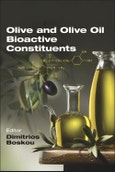The market is flooded with products posing as elixirs, supplements, functional foods, and olive oil alternatives containing phenols obtained from multiple olive sources. This technically-oriented book will be of value to nutritionists and researchers in the biosciences. It unravels the body of science pertaining to olive minor constituents in relation to new chemical knowledge, technological innovations, and novel methods of recovery, parallel to toxicology, pharmacology, efficacy, doses, claims, and regulation.
Topics include: the biological importance of bioactive compounds present in olive products; developments and innovations to preserve the level of bioactives in table olives and olive oil; and importance of variety, maturity, processing of olives, storage, debittering of olives and table olives as a valuable source of bioactive compounds.
- Presents detailed information concerning the claimed benefits of olive oil and discusses the permitted health claim to EFSA on oils with natural phenolics
- Recovery of bioactive constituents from olive waste is comprehensively described
- Explores the relationship betwen phenolic levels and sensory evaluation
- Features chapters on the clinical and cellular mechanisms and health effects of olive, important for functional foods research
Please Note: This is an On Demand product, delivery may take up to 11 working days after payment has been received.
Table of Contents
Chapter 1: Olive Fruit, Table Olives, and Olive Oil Bioactive ConstituentsChapter 2: Minor Bioactive Olive Oil Components and Health: Key Data for Their Role in Providing Health Benefits in Humans
Chapter 3: Cellular and Molecular Effects of Bioactive Phenolic Compounds in Olives and Olive Oil
Chapter 4: Olive Oil Phenolic Composition as Affected by Geographic Origin, Olive Cultivar, and Cultivation Systems
Chapter 5: Effect of Fruit Maturity on Olive Oil Phenolic Composition and Antioxidant Capacity
Chapter 6: From Drupes to Olive Oil: An Exploration of Olive Key Metabolites
Chapter 7: Research and Innovative Approaches to Obtain Virgin Olive Oils with a Higher Level of Bioactive Constituents
Chapter 8: Table Olives as Sources of Bioactive Compounds
Chapter 9: Bioactive Phenolic Compounds from Olea europaea: A Challenge for Analytical Chemistry
Chapter 10: Analysis of Bioactive Microconstituents in Olives, Olive Oil and Olive Leaves by NMR Spectroscopy: An Overview of the Last Decade
Chapter 11: Recovery of High Added Value Compounds from Olive Tree Products and Olive Processing Byproducts
Authors
Boskou, DimitriosDimitrios Boskou received his diploma and doctor's degree in chemistry from the School of Chemistry, Aristotle University of Thessaloniki, Hellas; his Ph.D.in Food Science from the University of London; and a Doctor of Science degree from the School of Chemistry, Aristotle University. He served as an assistant lecturer, assistant professor, associate professor, professor, and head of the Laboratory of Food Chemistry and Technology, School of Chemistry, Aristotle University (1970-2006). In the period from 1986 to 1998 he was a member of the IUPAC Oils, Fats, and Derivatives Commission. He served as a member of the Supreme Chemical Council, Athens (1995-2005), and a member of the Scientific Committee for Food of the European Commission and an expert of the Food Additives Panel of the European Food Safety Authority (1995-2012).
Dr. Boskou has published over 90 papers and reviews. He is the editor of 7 books and the author of 20 chapters in books related to the major and minor constituents of fats, natural antioxidants, olive oil, and heated fats, published in the United States, the United Kingdom, France, India, and Croatia. He is also a contributor to international scientific encyclopedias and the Lexicon of Lipid Nutrition, a joint IUPAC/IUNS work.








